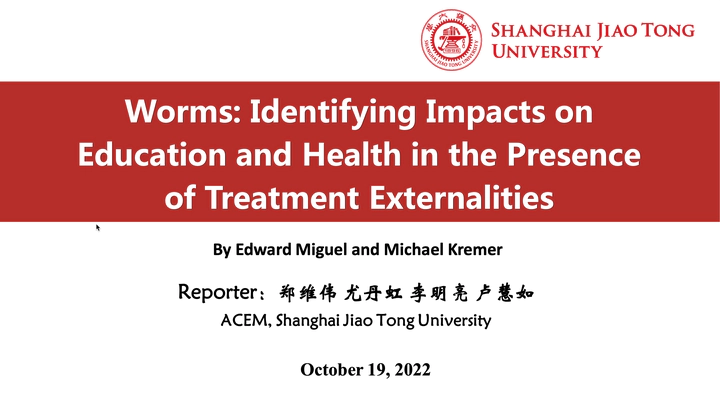Worms, Identifying Impacts on Education and Health in the Presence of Treatment Externalities
 Title Page: Econometrica
Title Page: EconometricaAbstract
Intestinal helminths—including hookworm, roundworm, whipworm, and schistosomiasis-infeet more than one-quarter of the world’s population. Studies in which medical treatment is randomized at the individual level potentially doubly underestimate the benefits of treatment, missing externality benefits to the comparison group from reduced disease transmission, and therefore also underestimating benefits for the treatment group. We evaluate a Kenyan project in which school-based mass treatment with deworming drugs was randomly phased into schools, rather than to individuals, allowing estimation of overall program effects. The program reduced school absenteeism in treatment schools by one-quarter, and was far cheaper than alternative ways of boosting school participation. Deworming substantially improved health and school participation among untreated children in both treatment schools and neighboring schools, and these externalities are large enough to justify fully subsidizing treatment. Yet we do not find evidence that deworming improved academic test scores.
HOOKWORM, ROUNDWORM, WHIPWORM, and schistosomiasis infect one in four people worldwide. They are particularly prevalent among school-age children in developing countries. We examine the impact of a program in which seventy-five rural Kenyan primary schools were phased into deworming treatment in a randomized order. We find that the program reduced school absenteeism by at least one-quarter, with particularly large participation gains among the youngest children, making deworming a highly effective way to boost school participation among young children. We then identify cross-school externalities—the impact of deworming for pupils in schools located near treatment schools—using exogenous variation in the local density of treatment school pupils generated by the school-level randomization, and find that deworming reduces worm burdens and increases school participation among children in neighboring primary schools. There is also some evidence of within-school treatment externalities, although given that randomization took place across schools, rather than across pupils within schools, we cannot use experimental identification to decompose the overall effect on treatment schools into a direct effect and a within-school externality effect, and must rely on necessarily more tentative non-experimental methods.
Citation: Miguel, E., & Kremer, M. (2004). Worms: identifying impacts on education and health in the presence of treatment externalities. Econometrica, 72(1), 159-217.